A one hour flight from Da Nang takes us to Saigon (Ho Chi Min City). We are not going to spend any time in this big bustling city, but are here to visit two bamboo factories, in the area around Saigon, in order to launch our climate adaptation solutions bamboo amphibious house project. (more on this later).
We are are about to rent a house for a while, outside Hoi An, in the little organic farm village of Tra Que. However, our house is not ready for us to move into. So, finding ourselves already in Saigon, we decide to hop on a plane after visiting the bamboo factories, and fly next door to Cambodia. It is a short one hour flight!
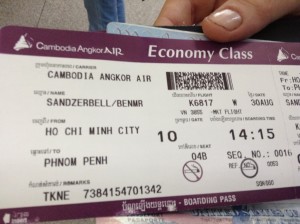 |
| How many conversations did we have in Granada about our upcoming travel adventures? This ticket is what these “visualizations” were about. Ho Chi Minh City (Saigon) to Phnom Penh, Cambodia. Exciting! |
Once in Phnom Penh, we take a tuk tuk towards the riverfront to find a place to sleep for the night. We are travelling light, with only our small backpacks in tow. Feels good to be so light!
There are signs everywhere in the most gorgeous looking calligraphy, which is Khmer, the language of the people of the once powerful and highly advanced Khmer civilization.
There is quite a feeling of hustle and bustle, with tuk tuks everywhere and as we wind through the streets to the riverfront, Bens’ mouth is watering at the sight of so many vendor carts selling crispy duck and whole fish on the sides of the street in the city.
We easily find a small hotel near the riverfront and the Royal Palace.
Tragically, when in Phnom Penh it is hard to avoid the gruesome scars of the horrific Pol Pot years from 1975 to 1979 when the Khmer Rouge systematically killed an estimated two million Cambodians, almost a fourth of the country’s population.
We are just starting a process of slow immersion into our new ASEAN “neighborhood”, and there is much to learn about the countries’ respective histories.
The genocidal policy of extinction of anyone deemed an “intellectual” and therefore a potential threat to the Pol Pot regime, resulted in urbanites forced to leave Phnom Penh en masse to hide and reinvent themselves overnight into “farmers/peasants”. Urbanites were killed through execution, starvation, disease and forced labor.
It is very strange to have tuk tuk drivers call out “Want to visit the Killing Fields? Want to go to the Genocide Museum?”
We make a conscious choice NOT to rush into this extraordinarily sad period in Cambodia’s history but rather to first gain a sense for the country through it’s much longer history which dates a thousand years. This history is rich with Buddhism, architectural and artistic achievements.
We discover that Cambodia has been the object of power plays between it’s two powerful neighbors Thailand and Vietnam and much before that, the country was tossed back and forth between the great powers of China and India, with an ultimate geopolitical compromise whereby China exerted more influence on Vietnam, while India exerted more influence on Thailand, Cambodia and Laos.
We head to the Royal Palace and the National Museum of Cambodia to get our bearings over this thousand year old kingdom. The National Museum is home to the worlds finest collection of Khmer sculpture. The Royal Palace is a striking structure near the riverfront, it is the official residence of King Sihamoni.
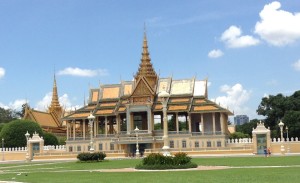 |
| The Royal Palace close to the riverfront. Home to the kings. |
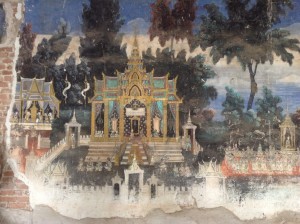 |
| Extraordinary extensive gorgeous frescoes painted all around the interior courtyard of the pagoda compound. These exquisite murals depict the classic Indian epic of Ramayama. |
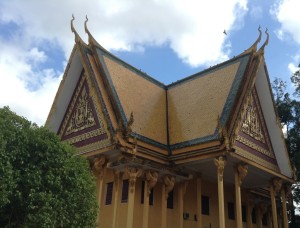 |
| Stunning bright sunflower yellow ceramic tiled roof. |
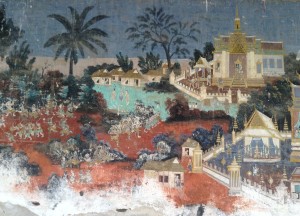 |
| The colors used in the mural are these gorgeous blues and greens, rust and gold leaf. |
Also of historical importance, and on top of a small hill, is Wat Phnom…
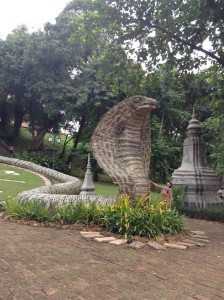 |
| In the park below Wat Phnom, a huge snake sculpture winds it way down the hill |
| Theravada branch of Buddhism practiced in Cambodia hails from India. The connectivity between this form of Buddhism and our yoga practice is omnipresent. |
|
Current favorite Buddha friend. Om Shanti Om
|
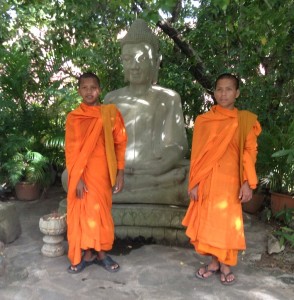 |
| The National University of Buddhism is located in Phnom Penh. We enjoyed quite a few nice conversations with several young monks in training, but also a few elders at one of the temples. |
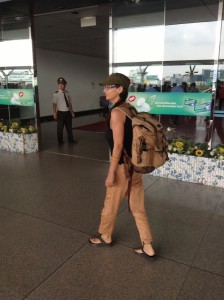
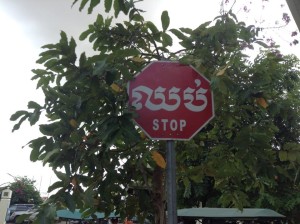
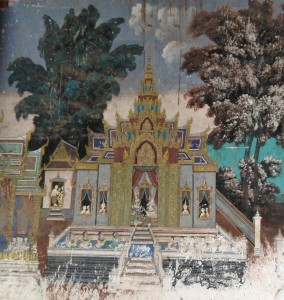
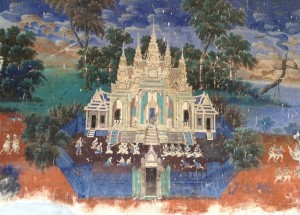
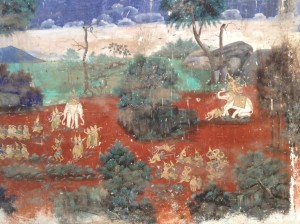
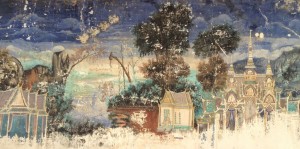
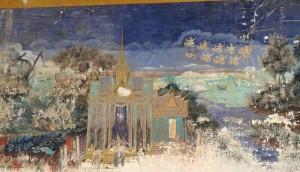
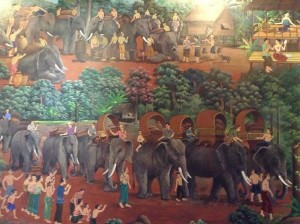
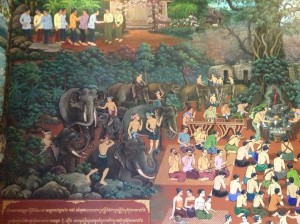
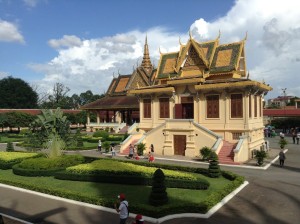
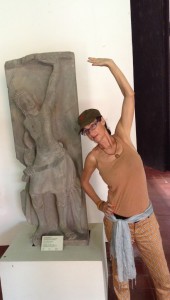

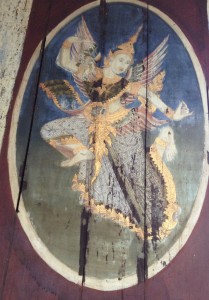
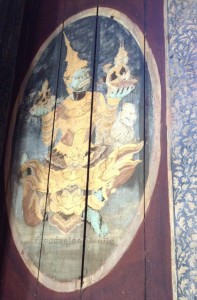

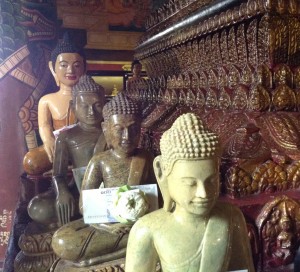
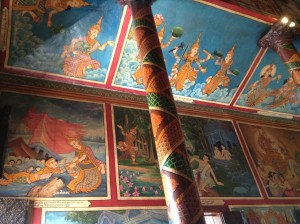
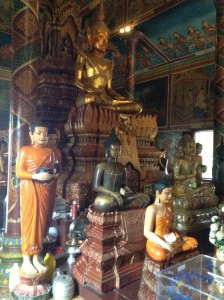
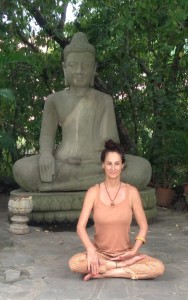
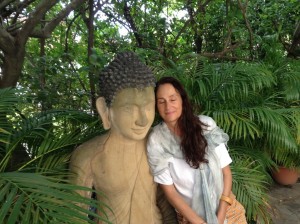
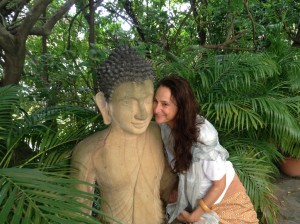
Well documented. Wish you all the best.
Wow!!! Beautiful and educational..a double whammy!!! Where’s the beef though? Foodie update please…
Never mind…I found the foodie update…yummy!!!!
How exquisite these” fresques” are…Thank you for all these fascinating comments. The architecture is so delicate and refined…More,more,more
JB, we KNEW you would love the colors and subtlety in painting of the “fresques” which depict the story of Ramanaya from India. There is a lot of Indian influence (Thai, Vietnamese, Chinese and French too) which is reflected in the arts, the food, the architecture and the culture.